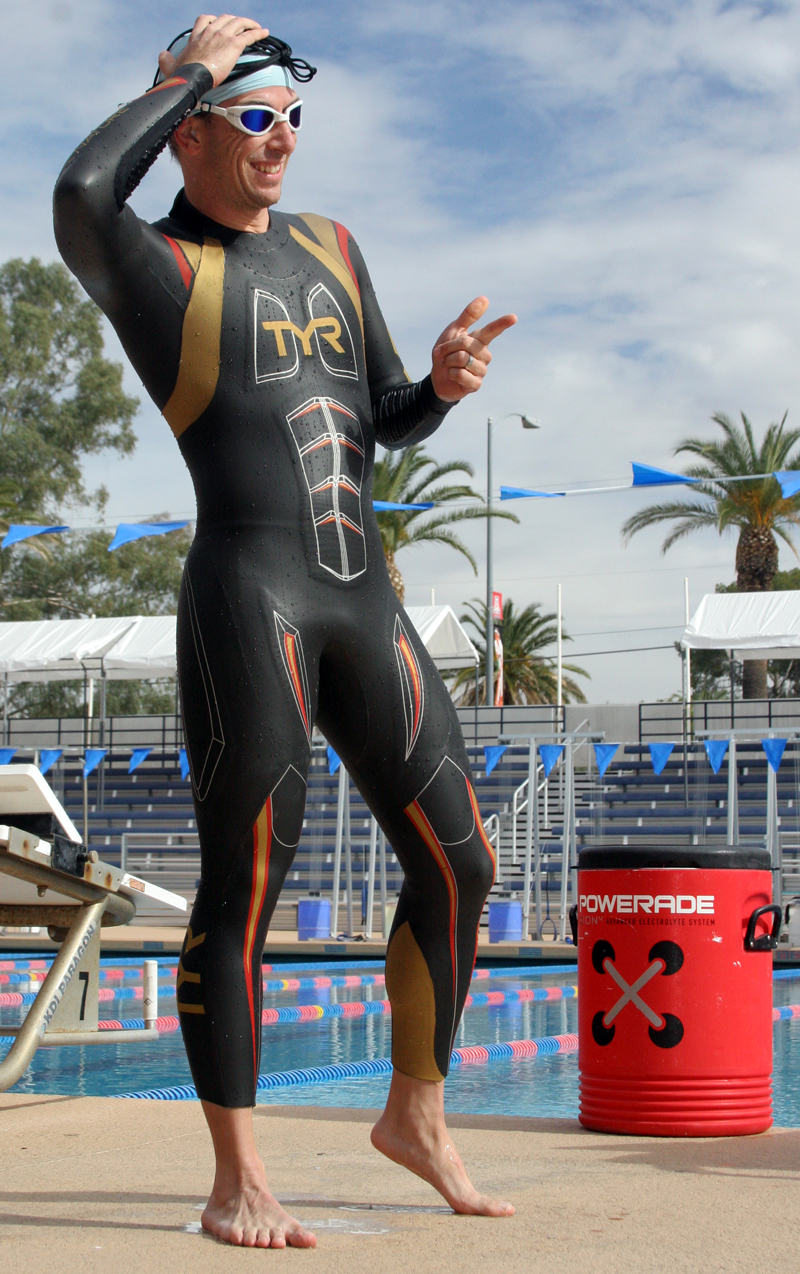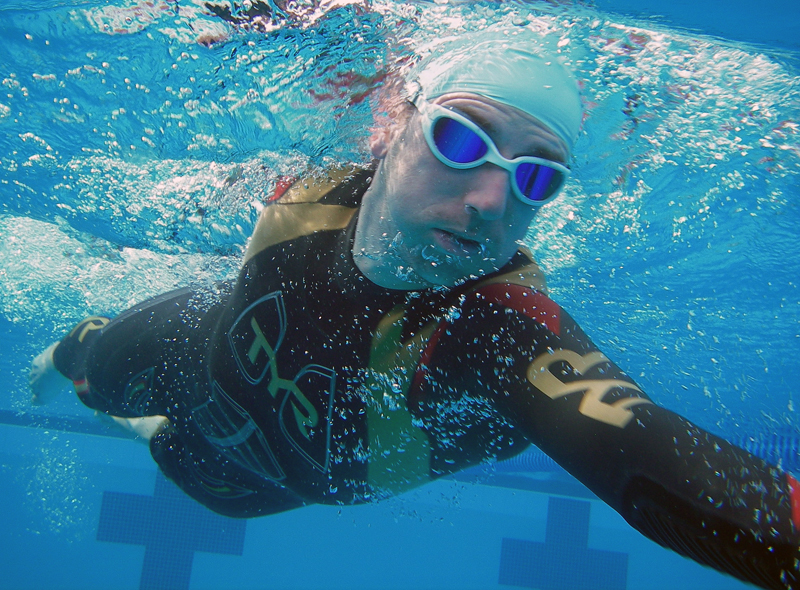
$1200 for a triathlon wetsuit? Really? Really.
The TYR Hurricane Freak of Nature grabs more attention for its MSRP than any other feature. At $1200, significantly more than any other wetsuit, the suit suggests a lot. Is it worth the price? Does it deliver on the $1200 promise?
Wetsuit prices have been on an upward spiral since their invention. Dan Empfield’s first triathlon full suits were $199 in 1988. Since the TYR Hurricane Freak of Nature is six times the price of Empfield’s original Quintana Roo Full Suit from 1988 the question has to be: Is a $1200 wetsuit six times better than a $200 wetsuit?
2XU has a $799 wetsuit with their Project X while $650 seems to be the price ceiling for most other brands. That puts the TYR Freak of Nature at almost double the price of most of the other high end competitors. But the discussion of the TYR Freak of Nature goes beyond price, although it always comes back to it.
TYR swimwear started about the same time as other early triathlon brands, 1985. Born in the surf capital of Huntington Beach, California and founded by 1976 Olympic Swim Team Captain Steve Furniss and Joe DiLorenzo the company was built around the specialty swim market. They leveraged a significant part of that market away from legacy brands like Speedo while also entering the multisport market with wetsuits and apparel. TYR’s mantra is “Made for swimmers by swimmers”. TYR developed ultra-lightweight carbon infused fabrics for use in their TYR Carbon line of triathlon apparel worn by Chrissie Wellington. The fabric weight is unusually light and thin but completely opaque with full stretch. Each of TYR’s triathlon specific product introductions have been innovative and novel.
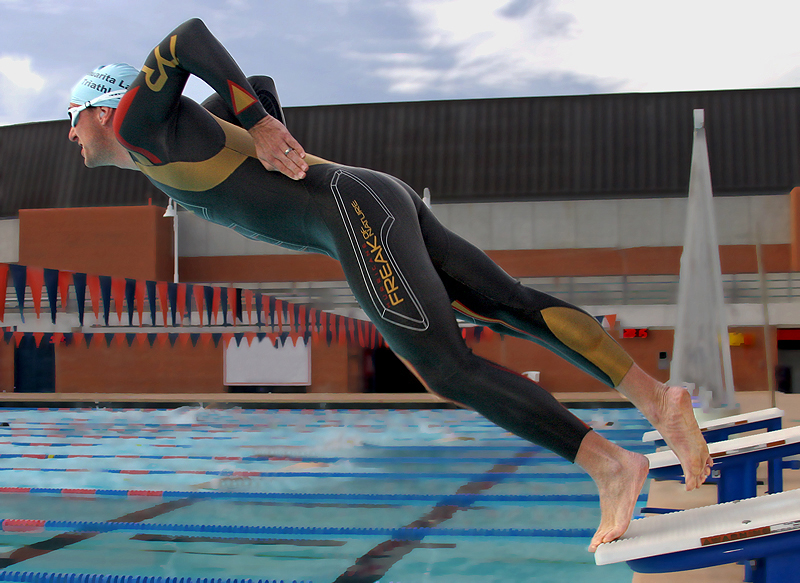
The TYR Hurricane Freak of Nature is TYR’s flagship wetsuit. The suit is made entirely of Yamamoto Smoothskin #40 neoprene.Yamamoto #40 has more stretch than any other commonly used neoprene. Yamamoto brand neoprene is used in more wetsuit brands than any other neoprene. Yamamoto started in 1961 making neoprene wetsuits for Japan’s elite underwater demolition teams and traditional Japanese fishing women who dive for oysters. Yamamoto claims a “90% market share” of the high end dive and swim wetsuit neoprene market.
A more flexible suit made from Yamamoto #40 accomplishes a few things:
- It is easier to put on and take off, especially aiding removal at race speed in transition.
- It has better “curb appeal”, allowing retailers to sell more wetsuits from a better dry land try on experience by the consumer. Because they’re easier to try on in the fitting room, they’re easier to get out the door.
- It fits more body types. Because of increased stretch the suit’s fit becomes more flexible.
- It is more flexible in the water, allowing swimmers to complete the stroke more easily.
Wetsuit flexibility is not the entire story of performance though. More flexible isn’t always faster. There is suggestion that high wetsuit flexibility may contribute to water absorption into the fabric lining over a long swim. This may result in gradual loss of bouyancy, especially if the suit is loose and/or poorly donned. The suit becomes “water logged”. As the suit’s liner soaks up water it begins to sink. In an odd paradox a more flexible suit may accelerate the process by permitting water inside the suit. In response to this several suits are designed with a non-absorbent linersuch as Aquaman and Profile Design’s “Metal Cell”. This smooth laminate on the inside of the suit prevents water-logging.

To test the theory we weighed a dry sample of 5 mm neoprene with a nylon lining cut from a wetsuit chest. After dry weighing we submerged it to 8 inches depth for 60 seconds and re-weighed it. Then we submerged it for 1:15:00, a middle of the pack Ironman swim duration, and weighed it again. It gained 18 grams when wet and a further 2 grams after 1:15:00 of submersion at 8″ depth. Spread over the entire surface of the suit the fabric does appear to gain some weight from being in the water. This does not account for water potentially taken on between the suit and the skin due to an ill fitting or poorly donned suit. While far from scientific this is an interesting idea. The edges of the neoprene sample are not finished in the test though. A complete wetsuit doesn’t have exposed fabric edges. It can’t soak up water through the unfinished edges, only the inner surface of the fabric. While that likely changes the rate of absorption in our sample, it may still suggest a trend in water absorption of nylon backed suits.
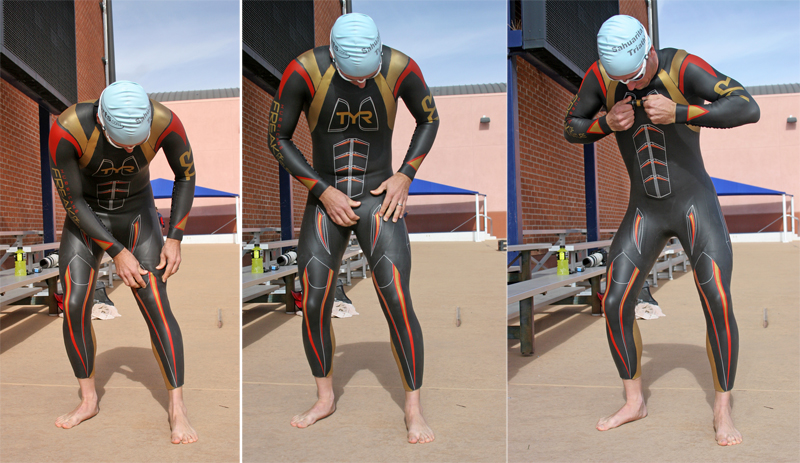
The suits with the smooth, non-textile liners such as Profile Design and Aquaman’s Metal Cell feel less flexible but may swim faster. Some results of swim tests performed in an open water lagoon in Curacao in the Dutch Antilles during the early 2000’s suggested these stiffer feeling suits were faster- despite them feeling stiffer. The suits do not provide as easy a try-on experience for consumers and have a tough time leaving the sales floor compared to ultra-flexible suits that pull on very easy for a dry land fit.
An interesting feature of the TYR Hurricane Freak of Nature is how it positions your body in the water. Since “waterline” of the swimmer is a key stroke component a wetsuit that helps float the swimmer’s legs and helps the swimmer rotate may offer an advantage. The TYR Hurricane Freak of Nature has extra floatation and rotation features in the legs and hips. TYR claims these features help the swimmer’s body position. Our observations may confrim this. Seton Claggett, who did substantial swimming in the TYR Freak of Nature for this test, reported enhanced body position while swimming. This extra floatation in the legs was “…something I really like…” according to Claggett. Top swim coaches often speak of “swimming downhill” and not letting the legs sink. The TYR Hurricane Freak of Nature is designed around that concept.
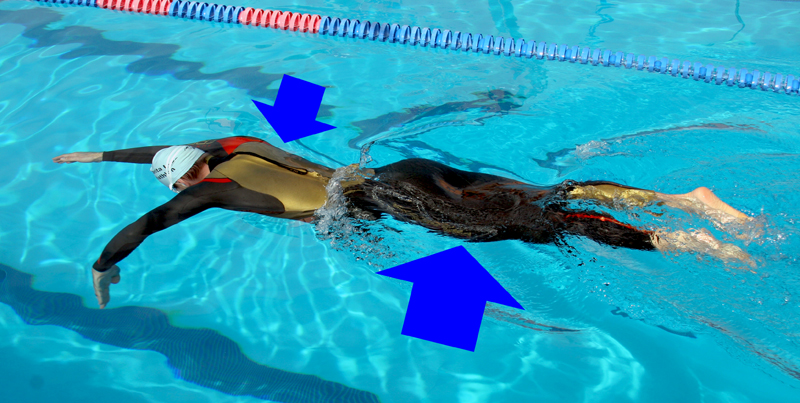
Another noticeable feature of the TYR Hurricane Freak of Nature are the V-GCP “pull panels” on the forearm section. A number of wetsuit manufacturers have built some type of grip device onto the forearm in the hope of increasing forearm “traction” and surface area in the water. The idea is to “hold onto” water better as you pull yourself forward. The V-GCP section also increases the surface area of the forearm. Our tester, Seton Claggett, said “The arm grippers on the Freak of Nature are like nothing I have ever swam in before, I am actually surprised they are legal because they do increase the surface area of the forearm resulting in the ability to hold more water, and hence go faster.” My experience with arm grippers also suggests better “grip” on the water, if for no other reason than greater shoulder fatigue in suits equipped with grippers. Another benefit may be increased awareness of stroke, compelling the swimmer to maintain better form during the “catch” phase.

TYR has built a series of textured panels into the suit. These “Elevation Panels” concentrate buoyancy and may influence hydrodynamics. The panels are most obvious from the inside of the suit. On the outside of the suit they look like dimples on a golf ball. The most significant panels may be the ones located on the outside of the upper thigh. These Elevation Panels help facilitate roll during the stroke cycle, improving form.
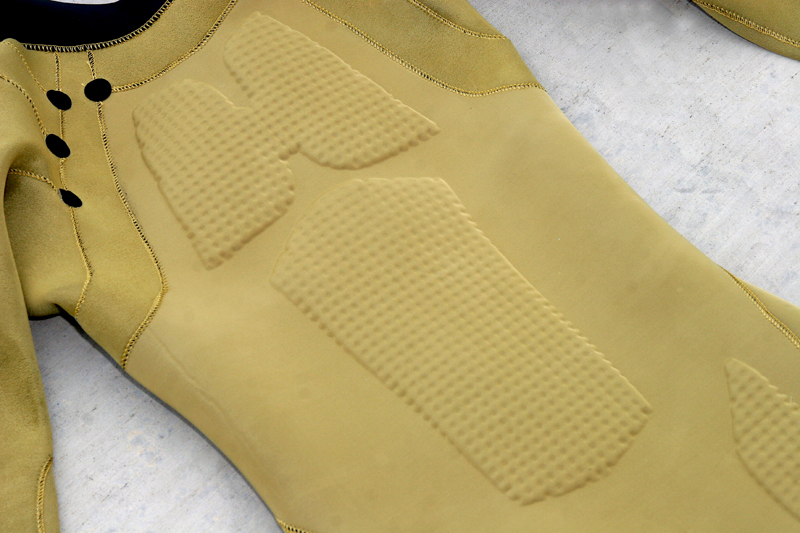
The other potential benefit to these textured panels is based loosely on the idea of “supercavitation”, a theory that a rough surface texture traps bubbles against the suit and these bubbles slide more easily through the water. The theory is proven. Underwater projectiles have been developed with supercavitation “bubble generators” to help them slip through the water easier. The dimpled surface of the TYR Hurricane Freak of Nature performs a similar function. This reduced friction supercavitation is visible when you watch a swimmer rotate their hips underwater wearing the suit, effectively sliding along on a small layer of bubbles.

Other basic construction features on the TYR Hurricane Freak of Nature are good design at the neck, leg and arm opening for comfort, no neck chafing, speed of exit from the suit and durability. The neck is low and has neoprene smoothskin on its inner surface for a good seal. Because it is low it likely won’t chafe most users. Leg and arms are seam tapped and speed cut for faster removal and good durability, a thoughtful feature in a high end racing wetsuit. Seam ends inside the suit are taped with a fabric dot for added durability.
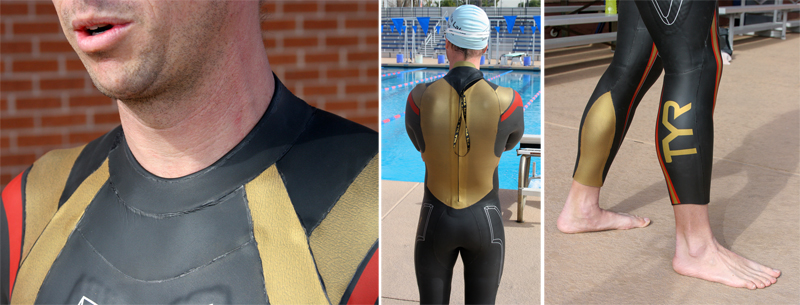
Overall attention to detail on inner seams and outer gluing of the suit panels is very good. Even minor features like the the loose running ends of stitching are glued down. This is no small feat since sewing the hyper-flexible Yamamoto #40 neoprene is like stitching thick skin. Seams also have to be arranged and sewn knowing how much the neoprene will stretch during donning and high speed removal in transition. It is difficult to make a Yamamoto #40 wetsuit very durable but TYR may have accomplished that with good attention to detail on the Freak of Nature. This meticulous level of construction accounts for a large part of the price on the suit.
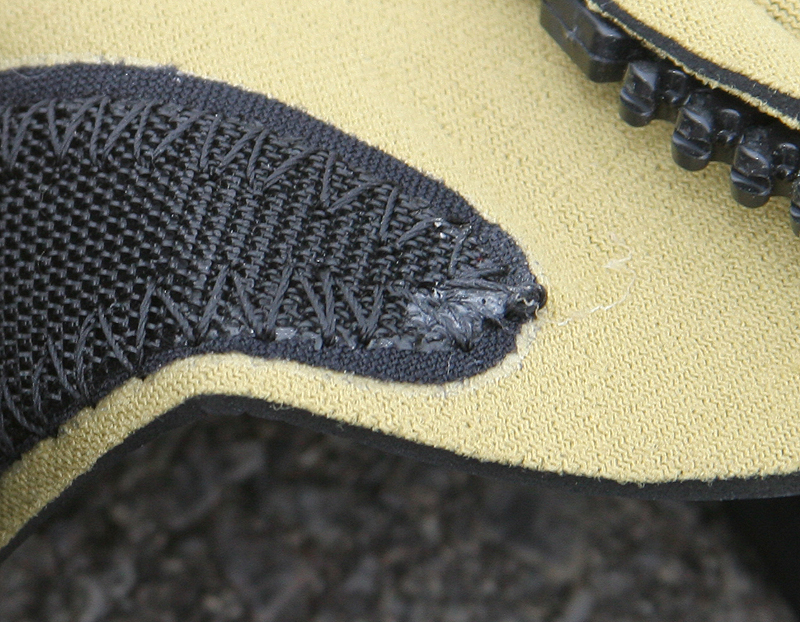
The gold lining of the suit picks up body marking from ink used to number your body during the race. It doesn’t change the wetsuit’s performance but it is worth knowing. When storing the suit follow TYR’s storage instructions, the same for all high quality wetsuits. I used a piece of Velcro pile to the hook closure at the neck when transporting the suit to prevent the Velcro hook closure patch from fraying the gold fabric suit lining. Since the suit comes with a nice carrying case you can just throw the little piece of Velcro pile in the case when you’re using the suit, then press it on when packing the suit for transport.
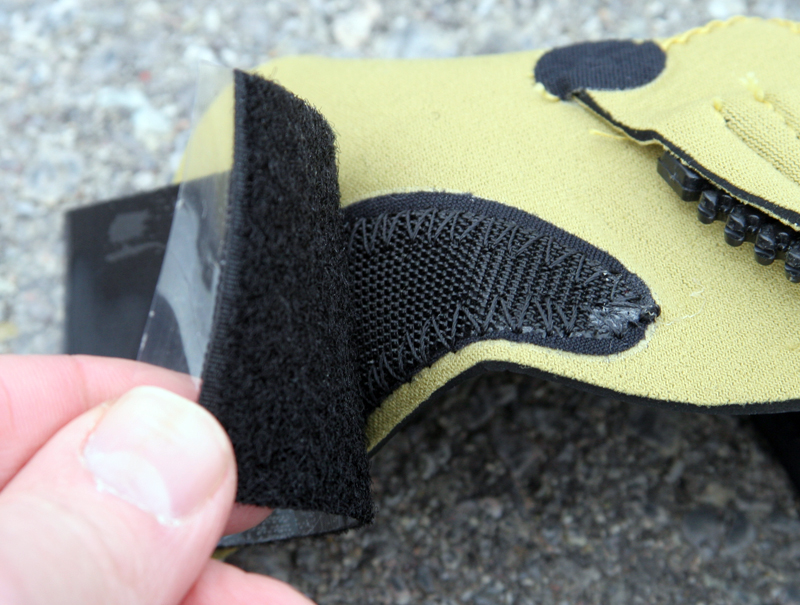
In the water Seton Clagget remarked about how the flexible Yamamoto #40 made breathing easier, “Two of my other favorite suits are the Blue Seventy Helix and the TYR Hurricane 5. All of these suits have the legs riding high in the water, something I really like, are incredibly flexible and comfortable in the arms/chest. Because the FoN has Yamamoto 40 throughout the suit it is a little easier to breath in than the Helix and the Cat 5.”
Claggett sized himself based on his previous experience with Yamamoto #40 wetsuits. “Getting the fit right on an all Yamamoto 40 suits is extremely difficult because the material is so flexible. TYR was able to accomplish great fit due to their development of a great jersey material that backs onto the neoprene. The fit of this suit is just like the Blue Seventy Helix and the Cat 5 – in my opinion, all of these suits fit the general population extremely well.”
The TYR Hurricane Freak of Nature is sold in 8 men’s sizes and 7 female specific patterned sizes. The suit comes with a carrying case and a swim cap.
Is the TYR Hurricane Freak of Nature worth its $1200 price tag? Seton Claggett put it this way:
“When you get into the upper end of technology the price begins to skyrocket compared to the small gains. If you are looking for that extra little bit, like all technology, it is going to cost you. So, if you are new to the sport then I would never consider this suit. If you are a veteran who enjoys the lifestyle then I wouldn’t get this suit. If you are on the bleeding edge and you are here to kick ass and take names (and have the money) then I would get this suit.”
There is no denying this is a very, very nice suit. TYR build a comfortable, swimmable high performance racing wetsuit with added durability features and every current performance design feature. The suit is also flashy looking. Whether that represents good value to a given customer is more a function of their discretionary income and willingness to part with it than anything else. It’s an individual decision. For those who do make the leap to TYR’s flagship $1200 Hurricane Freak of Nature they will get a well designed, beautifully made suit that swims great. It may be tough to put a price on that.
